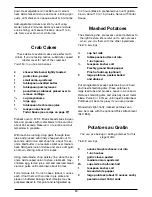
12
Soft dough or liquid leaks onto base of food
processor
Always start processor before adding liquid
and add liquid only as fast as dry ingredients
absorb it.
Motor stops
• If using large feed tube cover, the pusher
assembly may have come unlocked. Push down
pusher sleeve to lock it into place and continue
processing.
• Cover may have come unlocked. Lock cover and
continue processing.
• Power cord may be unplugged.
• Excessive strain may have caused motor to
overheat and stop. Wait for the motor to cool,
5–10 minutes. A safety protector in the motor
protects it against excessive overheating. If the
motor stops, turn the machine off. After 5–10
minutes, divide dough into 2 batches and com-
plete processing. Pinch dough to make sure it
is not too stiff to knead comfortably by hand. If
it is, add liquid – 1 tablespoon at a time – until
dough is sufficiently moist to clean bowl.
Dough doesn’t rise
We recommend that you always test activity of
yeast before using it. See instructions for proofing
yeast on page 10. Do not use dry yeast after expi-
ration date on package.
Avoid killing yeast cells by dissolving yeast in
water that is too warm. Dissolve yeast in about
1⁄3 cup of warm liquid at 105°F–110°F. All other
liquids should be cold.
Don’t knead so long that dough becomes over-
heated. The ideal temperature for kneaded dough
is 80°F; it should never exceed 100°F.
Let dough rise in draft-free environment of
about 80°.
Dough containing whole-grain flour will take lon-
ger to rise than dough made of white flour only.
Baked bread is too heavy
Next time, feel dough to be sure it is uniformly
soft, pliable and slightly sticky before setting it
aside to rise. Let dough fully double in bulk in
bowl or bag, punch it down, then let it double
again after it is shaped.
PROBLEMS AND SOLUTIONS WITH TYPICAL
SWEET DOUGHS
Motor slows down
• Amount of dough may exceed maximum capac-
ity of your food processor. Remove half and
process in 2 batches.
• Don’t process too long after all the ingredients
have been incorporated. These rich doughs will
give you good results after only 30 seconds of
kneading.
PREPARING FOOD FOR
SLICING AND SHREDDING
Round fruits and vegetables
Before processing onions, apples and other
large, round fruits and vegetables, trim them with
a knife. Cut the bottom ends flat, to make the
food lie stable on the disc.
Place the food in the feed tube, flat side down.
Position it as far left as possible, to prevent it
from tilting when being processed.
Choose fruits that are firm and not too ripe.
Always remove large, hard pits and seeds from
fruits before processing. Seeds from citrus fruits
need not be removed. You may remove the rind
before slicing or shredding, or leave the rind on.
Whole peppers are an exception
Remove the stem and cut the stem end flat.
Remove the core and scoop out the seeds. Leave
the end opposite the stem whole, to keep the
structure stiff. This ensures round, even slices.
Large fruits like pineapple and cantaloupe
Cut them in half and remove the seeds or core. If
necessary, cut the halves into smaller pieces to fit
the feed tube. Remember to cut the ends flat.
Cabbage and iceberg lettuce
Turn the head on its side and slice off the top and
bottom, leaving a center section about 3 inches
deep. Remove the core and cut the center sec-
tion into wedges to fit the feed tube. Remove the
core from the bottom piece and cut it and the top
piece into wedges to fit the feed tube. The 2mm
Slicing Disc or the optional 1mm Slicing Disc are
excellent for slicing cabbage for coleslaw.
If the fruit or vegetable doesn’t fit
Try inserting it from the bottom of the feed tube.
The opening there is slightly larger. Do not force
any food into the feed tube.
Содержание PRO CUSTOM 11 DLC-8S
Страница 17: ...17 NOTES ...
Страница 35: ...35 NOTES ...
Страница 36: ... 2016 Cuisinart 150 Milford Road East Windsor NJ 08520 Printed in China 16CE019155 G IB 4274 ESP ...













































